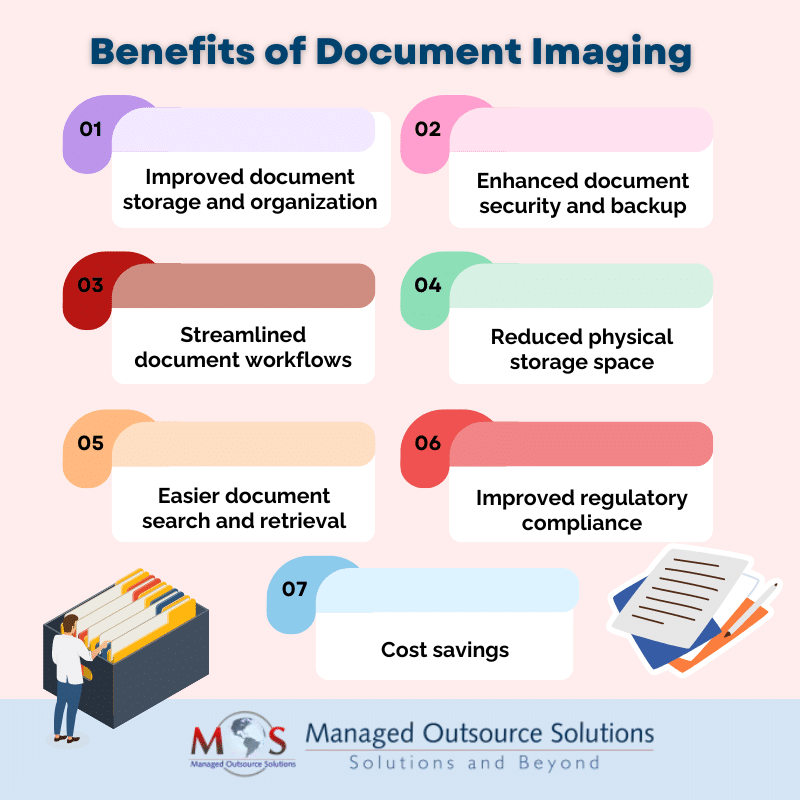Despite the shift towards digitization in offices, a lot of information is still stored on paper. Managing documents manually wastes a lot of time. In a 2023 Adobe Acrobat survey, 48 percent of employees said they struggle to find documents quickly, while 47 percent feel their company’s online filing system is confusing and ineffective. Adopting an efficient and modern document management is crucial for companies of all sizes. That’s where scanning and imaging comes in. Industries such as legal, finance, real estate, medicine, and education rely on document imaging and bulk document scanning services to capture and manage documents in digital format.
According to Future Insights, the global document imaging market is expected to grow from US$ 119.7 billion in 2022 to US$ 267.7 billion by 2029, with a CAGR of 12.2% during the forecast period. Let’s explore what document imaging involves, how it is different from document scanning, and what makes it a valuable business solution.
Document Imaging: Create an Electronic Workflow
Document imaging is a key component of an effective document management system. The process utilizes specialized software and hardware to digitize files. A document image processing system consists of scanners/optical character recognition (OCR), image compression/decompression boards, mass storage devices, laser printers, and indexing/ retrieval software.
Imaging involves replicating paper documents. The software first creates an image of the scanned document in a preferred format, such as TIFF, JPEG, PNG, or BMP. Optical Character Recognition (OCR) software then converts the image into a machine-readable text document. Once OCR processing is over, the documents can be indexed using the full text or metadata. Once the system converts the information into digitized images, they can be compressed and stored in a centralized, searchable repository.
Imaging is a valuable solution for large enterprises that handle a constant stream of paper documents across multiple locations. By scanning and indexing the documents as they are received, they can integrate these documents into their electronic workflow.
How Document Imaging differs from Document Scanning
Imaging is a comprehensive process and provides more robust document management capabilities compared to basic scanning. Document imaging involves capturing, storing and managing files in a digital format using specialized software and hardware. It typically includes OCR to make documents searchable, workflow automation, and integration with enterprise content management (ECM) systems.
Document scanning is a simpler and more basic process than document imaging. Scanning involves the conversion of physical documents to digital format using a scanner. The scanned documents are usually saved as image files (e.g., PDF, TIFF, JPEG), and stored locally or in cloud-based storage. Scanned documents lack the advanced features and integration capabilities of a full document imaging solution.
Organizations leverage document scanning solutions to digitize their documents. By implementing document imaging they can store, manage, and access their information more efficiently, improving functionally and productivity.
Key Factors Driving the Demand for Document Imaging
Imaging enables businesses to move to digital document workflows that not only save information, but also extract value from it.
Several factors continue to drive the demand for scanning and imaging services.
Managing Big Data
As the volume of documents increases, imaging helps organizations to implement document management systems that can handle the influx of data, provide intelligent search and retrieval capabilities, and facilitate seamless collaboration.
Migration to the Cloud
As organizations seek to improve operational efficiency and scalability, investing in cloud storage solutions has become a strategic priority. According to Fortune Business Insights, the global cloud security market size is projected to grow from USD 43.74 billion in 2024 to USD 156.25 billion by 2032, exhibiting a CAGR of 17.3% during the forecast period.
This shift towards cloud-based infrastructure enables them to store larger volumes of data and streamline their workflows and improve collaboration. By moving document management processes to the cloud, businesses can scale their storage capacity and processing power to keep pace with the ever-growing demands of big data. Many banks and other financial institutions have moved to the cloud. The CEO of Bank of America says that the Bank saved $2 billion per year by building its own cloud.
Cloud-based document management platforms also provide seamless access to digital documents from any device, facilitating remote work and collaboration. Mobile apps and cloud integrations allow users to capture, edit, and share documents on-the-go, improving productivity and efficiency.
Mobile Data Capture
Mobile data capture has revolutionizing document imaging on the go. The ability to capture, process, and manage documents on the move is becoming increasingly essential in today’s dynamic business scenario. Mobile data capture leverages the power of mobile devices to empower employees and improve workflows. Driven by the Bring Your Own Device (BYOD) trend, these handheld devices have become indispensable for on-the-go data capture. Smartphones, tablets, and laptops allow mobile workers to ensure on-the-go data capture, transforming how organizations approach document imaging and management.
Digital Document Workflows
Document management systems leverage the digitized documents created through imaging to provide robust indexing and search capabilities. Digital document workflows allow users to save information as well as to make sense of data, and extract value from it. OCR can recognize the text and data within documents, allowing them to be electronically edited, searched, stored, and managed. Metadata, such as document titles, keywords, and other identifying information can be associated with the digital files to enable quick and efficient retrieval.
While document imaging paves the way for digitization, new-age technologies have significantly expanded the capabilities of digital documents. Artificial Intelligence (AI) and Machine Learning (ML) enable intelligent information processing, going beyond the basic digitization and storage provided by traditional document imaging and management systems.
Optimizing Document Scanning and Imaging
In today’s fast-paced, data-driven business environment, managing and leveraging documents efficiently is critical to achieve competitive advantage. Document imaging and scanning has emerged as a valuable business tool, enabling organizations to boost efficiency, productivity, and strategic insight. Partnering with a professional document scanning company is a practical way to digitize large volumes of physical documents and implement robust document management practices to capture, manage, and leverage their valuable information assets.
Document scanning solutions tailored to your unique needs!





